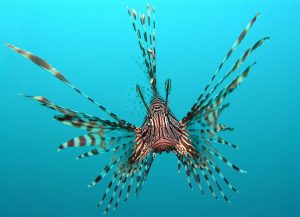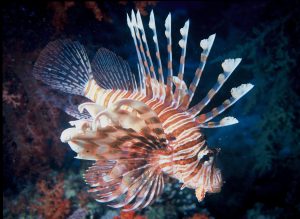by Linda Butcher

Pterois is a genus of venomous fish, commonly known as lionfish. It is native to the South Pacific and Indo-Pacific Ocean. The lionfish has been found from the New England coast to the Caribbean, into the Gulf of Mexico and as far south as Brazil. They can survive in brackish water and estuarine environments up to four miles inland. Once thought to be a warm shallow water reef fish, they have been found to depths of one thousand feet in the cold water off the coast of New York.
The typical lionfish has a total of 18 venomous spines. The dorsal fin has 13 long spines. Each pelvic fin has a short spine and the leading edge of the anal fin has three short spines. Lionfish have no natural predators and are susceptible to very few parasites compared to other fish.
Lionfish are able to reproduce in the first year of life. Most fish native to the Western Atlantic take three to five years to reproduce. Lionfish breed throughout the year. Potentially the fastest breeders in the Western Atlantic, they can lay 30,000 eggs every four days. Eggs can travel with the currents which makes it possible to spread to large areas of reefs. Their eggs do not go into the food chain because the eggs have a toxic coating to protect them.
The eggs hatch into larvae in 24-36 hours. They have a large head with long serrated spines. The larva are good swimmers and eat small ciliates (protozoans) and zooplankton only four days after hatching. The larvae becomeadult lionfish in approximately three months. Lionfish are thought to live approximately ten years in the wild; they have lived as long as 35 years in captivity. As voracious feeders, they will eat anything that fits in their large mouth.
Lionfish were first discovered in our side of the world in the early to mid 1980’s. It is not clear if the introduction was accidental or intentional, but most likely came from the aquarium trade. Lionfish are not bad they just do not belong in the Atlantic Ocean. At this time, there hasn’t been a practical way to contain their numbers.
According to Texas Parks and Wildlife Department (TPWD), “In Texas waters, lionfish have not yet become as prevalent as they have in other areas of the Gulf and Atlantic. Our best means of defense is to educate the public and encourage harvest of lionfish to remove them from our waters before they become an issue. We need to be pro-active in dealing with this potentially harmful invader. The more eyes we have on the water, the better.”
If you see a lionfish you should report its location to TPWD at 361-972-6253 (Leslie Hartman).

Along to the Texas coast, divers report seeing lionfish on oil rigs, ship wrecks, and even coral reef in the Flower Garden Banks National Marine Sanctuary. Lionfish are thought to be nocturnal, mainly hunting in the morning and evening and hiding in crevices during the day.
Lionfish are delicious to eat. They have flaky white flesh that is mild and buttery, similar in taste to grouper or hogfish. The meat contains a high concentration of Omega 3 fatty acids and high in lean protein. Once the venomous spines are removed, they can be prepared like any other fish. Entire cookbooks have even been written which are devoted to lionfish preparations.
The environmental community is urging restaurants to start serving lionfish. SO….SAVE OUR OCEANS….EAT MORE LIONFISH !!!!!
